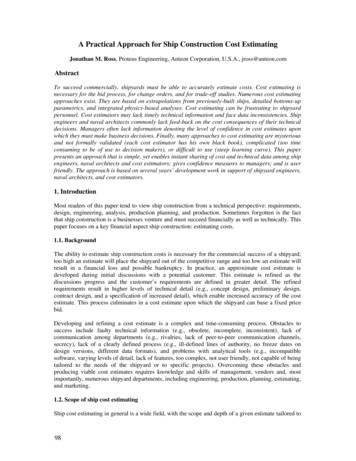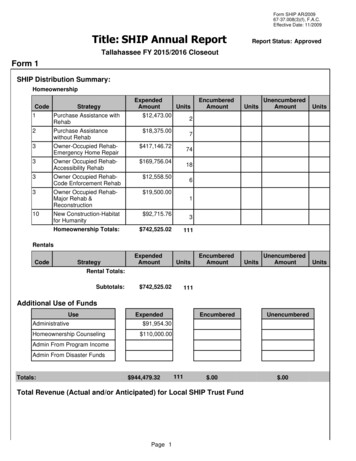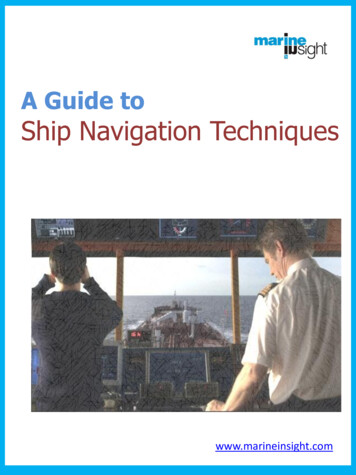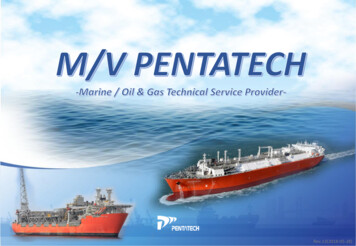
Transcription
A Practical Approach for Ship Construction Cost EstimatingJonathan M. Ross, Proteus Engineering, Anteon Corporation, U.S.A., jross@anteon.comAbstractTo succeed commercially, shipyards must be able to accurately estimate costs. Cost estimating isnecessary for the bid process, for change orders, and for trade-off studies. Numerous cost estimatingapproaches exist. They are based on extrapolations from previously-built ships, detailed bottoms-upparametrics, and integrated physics-based analyses. Cost estimating can be frustrating to shipyardpersonnel. Cost estimators may lack timely technical information and face data inconsistencies. Shipengineers and naval architects commonly lack feed-back on the cost consequences of their technicaldecisions. Managers often lack information denoting the level of confidence in cost estimates uponwhich they must make business decisions. Finally, many approaches to cost estimating are mysteriousand not formally validated (each cost estimator has his own black book), complicated (too timeconsuming to be of use to decision makers), or difficult to use (steep learning curve). This paperpresents an approach that is simple, yet enables instant sharing of cost and technical data among shipengineers, naval architects and cost estimators; gives confidence measures to managers; and is userfriendly. The approach is based on several years’ development work in support of shipyard engineers,naval architects, and cost estimators.1. IntroductionMost readers of this paper tend to view ship construction from a technical perspective: requirements,design, engineering, analysis, production planning, and production. Sometimes forgotten is the factthat ship construction is a businesses venture and must succeed financially as well as technically. Thispaper focuses on a key financial aspect ship construction: estimating costs.1.1. BackgroundThe ability to estimate ship construction costs is necessary for the commercial success of a shipyard;too high an estimate will place the shipyard out of the competitive range and too low an estimate willresult in a financial loss and possible bankruptcy. In practice, an approximate cost estimate isdeveloped during initial discussions with a potential customer. This estimate is refined as thediscussions progress and the customer’s requirements are defined in greater detail. The refinedrequirements result in higher levels of technical detail (e.g., concept design, preliminary design,contract design, and a specification of increased detail), which enable increased accuracy of the costestimate. This process culminates in a cost estimate upon which the shipyard can base a fixed pricebid.Developing and refining a cost estimate is a complex and time-consuming process. Obstacles tosuccess include faulty technical information (e.g., obsolete, incomplete, inconsistent), lack ofcommunication among departments (e.g., rivalries, lack of peer-to-peer communication channels,secrecy), lack of a clearly defined process (e.g., ill-defined lines of authority, no freeze dates ondesign versions, different data formats), and problems with analytical tools (e.g., incompatiblesoftware, varying levels of detail, lack of features, too complex, not user friendly, not capable of beingtailored to the needs of the shipyard or to specific projects). Overcoming these obstacles andproducing viable cost estimates requires knowledge and skills of management, vendors and, mostimportantly, numerous shipyard departments, including engineering, production, planning, estimating,and marketing.1.2. Scope of ship cost estimatingShip cost estimating in general is a wide field, with the scope and depth of a given estimate tailored to98
meet the needs of the user. Typical examples include the following:- Construction (acquisition) costs – shipyard labor and material costs for design/engineering,production and testing- Life cycle costs – construction costs plus maintenance, operation, support, and modernization- Total ownership costs (applicable to naval ships or certain large commercial fleets) –construction, life cycle costs plus infrastructure costs for training, and other indirect costs.Although this paper addresses cost estimating for new construction, a similar approach may be used toestimate costs for major repairs, overhauls, modernization, and disposal.1.3. Example Approaches to Cost EstimatingApproaches to cost estimating vary from the informal to the formal, as described below:- “Black book” – cost estimators create formulas, tables, and charts based on years of experience,industry trends, and vendor data. Typically, estimators guard this information closely, thusmaking its accuracy difficult to confirm. The black book approach can produce acceptable resultsin cases where the shipyard constructs a single or a few ship types and sizes. This approach is notso dependable for ship types or sizes beyond those normally constructed at the yard, or as costsbecome outdated.- Parametric approach – System and subsystem costs are characterized in a spreadsheet or costestimation program as a proportion of overall metrics such as length, volume, displacement andpropulsion power. The proportions are estimated through comparisons with similar ships. As withthe black book approach, if correlation levels are high, then the parametric approach yields goodpredictions; otherwise, the estimates may not be sufficiently accurate for many technical andbusiness decisions.- Standard ship approach – Some shipyards offer standard ship designs for which costcharacteristics are well known. This enables the yards to very quickly and confidently developdetailed bids for prospective customers, and is an excellent solution if the designs match thecustomers’ requirements. However, even with the flexibility for making limited changes to thedesign, many customers prefer to purchase a ship that is more closely aligned to their businessneeds.- Direct analysis approach – As the design matures, costs may be estimated based on drawings,bills of materials, historical vendor costs, and existing quotes. This approach is only practical afterthe design has reached a level of significant technical maturity.Shipyards may use combinations of the above approaches. For example, the parametric approach maybe used for structure, but the engineering approach may be used for owner-specified engine andauxiliary equipment. Cost estimates may be carried out by hand, spreadsheet, or on a computerprogram, and analysis results may be presented at various levels of detail.1.4 Organization of this paperThe remainder of the paper presents a practical approach for ship construction cost estimating and isorganized as follows:- Cost estimating approach requirements- Cost estimating approach description- Case study using the cost estimating approach- Conclusions- References.2. Cost Estimating Approach Requirements“The cost estimating approach” presented in this paper complies with the following requirements:- Three-tiered hierarchy of cost estimates to reflect varying levels of detail available to the costestimator during the design process99
-Each tier is independent of the others, permitting the best information to be used at all times, andnot requiring that the estimate adhere to the “lowest common denominator” of informationMaterial and labor elements are included (some shipyards may desire labor hours instead of laborcost because of confidentiality concerns)Confidence levels are presented to reflect the perceived accuracy of the engineering data and thecost estimating relationships.Each of these requirements is discussed below (Ross 2002).2.1 Three-tiered hierarchyThe cost estimating approach is divided into three tiers in order to reflect the three design phases(concept, preliminary, contract) commonly encountered in ship construction, Fig.1. At times, datamay be available at different levels, and thus be placed in different tiers (see the following section,“Independence among tiers”). However, the norm is for data to be of a fairly consistent level of detailamong the various parts of the ship (e.g., structure, propulsion, electric plant) during a given designphase. Thus, the corresponding tier is populated with technical and cost data during each of the threedesign phases, as described in the following paragraphs.First TierConcept Design1-Digit SWBSShip CharacteristicsLevel of DesignLevel of SWBSLevel of InformationSecond TierPreliminary Design2-Digit SWBSSystem CharacteristicsThird TierContract Design3-Digit SWBSSub-system CharacteristicsFig.1: Three-tiered hierarchy of ship construction cost estimatingThe first tier is Concept Design and is the least detailed. Typically this tier is used at the start of thecost estimating process when only limited information is available to the shipyard. This correspondsto elements of a 1-digit ship work breakdown structure (SWBS) and is based on about 20 dataelements relevant to the whole ship (e.g., length overall, displacement, propulsion power).The second tier is Preliminary Design. This corresponds to elements of a 2-digit SWBS and is basedon about 125 data elements relevant to ship systems (e.g., structural system, propulsion system,heating and ventilation system).The third tier is Contract Design and is the most detailed. The cost bid is based on the information inthis tier. This tier corresponds to elements of a 3-digit SWBS and is based on hundreds or thousandsof data elements relevant to sub-systems (e.g., main engine cooling, main engine fuel pumping, mainengine starting).2.2 Independence among tiersIndependence among the tiers allows the cost estimator to develop the estimate based on technicaldata of varying degrees of detail. For example, hull structure data may be available at the 3-digitSWBS level (e.g., 117 – Transverse Framing), but propulsion plant data may be available only at the100
2-digit level (e.g., 220 – Engineering Control Systems). The cost estimating approach will accept dataand produce reports for each of these SWBS levels. Thus, it is not necessary to wait until 3-digitpropulsion data is available before populating structures at the 3-digit level of detail. Independenceamong tiers enables the cost estimate to be based on the most detailed (and presumably the mostaccurate) data available.2.3 Material and labor includedShipyards commonly divide costs into material and labor (material includes vendor and subcontractorcosts, and labor is only that of shipyard employees). In order to best serve the shipyard needs, the costestimating approach follows this convention by producing estimates for material and labor. Materialestimates are provided as costs, but labor estimates are provided as labor hours (to maintainconfidentiality of shipyard labor rates). Estimates are provided for each SWBS element for whichtechnical data is available.2.4 Confidence levelsShipyard management needs to know the level of accuracy of the cost estimate in order to properlydevelop the bid. Put another way, management needs to know the level of uncertainty of the estimate.Uncertainty may be quantified either through the application of margin or the provision of confidencelevels. Both are commonly subjective, though probabilistic calculations may be used.The cost estimating approach uses confidence levels instead of margins. This is because confidencelevels provide the user (e.g., management) with quantified insight into the accuracy of the estimate.With this knowledge in hand, if certain parts of the estimate have low confidence levels, thenattention may be focused there to increase confidence levels, and thus increase the accuracy of theestimate. Confidence levels are assigned to the engineering quantities (e.g., reflecting a 90%confidence that the weight of structure is correct as reported) and also to the cost estimatingrelationships (e.g., reflecting 95% confidence in the estimated cost per weight factor). The twoconfidence levels are multiplied to arrive at an overall confidence level (e.g., 90% x 95% 86%).Confidence levels are presented by SWBS element.3. Cost Estimating Approach DescriptionShipyards commonly develop ship designs in the engineering department and develop ship costestimates in the cost estimating department. The cost estimating approach is designed to support thisdivision of labor, and was developed through input from engineers, cost engineers, and costestimators. Key to the development success to date were workshops at which shipyard technical andcost personnel suggested enhancements to early versions of the cost estimating approach.3.1. Description of the architectureThe cost estimating software is divided into two linked elements, one focused on engineering and theother focused on cost. Each element is comprised of modules which carry out discrete operations. Afunctional flow chart of the software is shown in Fig.2.The engineering element comprises the following five modules:- Baseline ship engineering quantities – This module is used in the case where the design ship (i.e.,the ship for which cost is being estimated) is an extrapolation of a baseline ship (i.e., a ship forwhich costs are known). This module is populated with data which describes both ships in termsof selected physical quantities (e.g., tonnes of structural steel).- Baseline and design ship principal particulars – Again, this component is used if there is abaseline ship. The module is a repository for general (non-SWBS) data such as length betweenperpendiculars.- Parametric engineering quantities – Parametric calculations are carried out in this module to101
-estimate design ship engineering quantities, based on a constant times the ratio of correspondingdesign and baseline ship principal particulars (e.g., [constant] x [design ship length overall] /[baseline ship length overall]).Assigned engineering quantities – As naval architects and marine engineers develop the design,increasingly accurate engineering quantities become available for use in the cost estimatingprocess. These “assigned quantities” are entered into this module. Normally, these engineeringquantities are more accurate (higher confidence level) than the parametric engineering quantitiesof the previous module.Baseline ShipEngineering QuantitiesUser enters quantitiessuch as weight andpower, from baselineship.Baseline and DesignShip PrincipalParticularsUser enters quantitiessuch as displacementfor parametric basis.Parametric EngineeringQuantitiesUser selects parametric basis andconfidence factors, and quantitiessuch as weight and power areproportioned from baseline ship.Engineering Quantities SourceSelectionUser selects AssignedEngineering Quantities orParametric EngineeringQuantities.ENGINEERINGAssigned Engineering QuantitiesUser assigns quantities such asweight and power, fromengineering and design analyses.Included are confidence factors.Parametric CostsCost is proportioned from baselineship cost and parametric basis(such as displacement). Userselects cost confidence factor.Assigned CostsUser assigns costs and confidencefactors.Cost Source SelectionUser selects Parametric Costsor Assigned Costs.COSTCost ReportsReports are developed for 1-,2-, and 3-digit SWBS items.Fig.2: Flow Chart of Cost Estimating Approach-Engineering quantities source selection – Here the user selects which engineering quantities(parametric or assigned) will be used in the cost estimating process. Normally, at the start of thedesign process, parametric engineering quantities are selected, and as the design progresses,assigned engineering quantities are selected.The cost element comprises the following four modules:- Parametric cost – As with parametric engineering quantities, cost is estimated for the design shipbased on a proportionality with regard to the baseline ship.- Assigned costs – As with assigned engineering quantities, assigned costs are directly entered intothe module. These costs are based on data such as initial estimates from vendors and frompurchase orders.- Cost source selection – Again, as with the parametric engineering quantities source selection, theuser selects between the parametric and the assigned values.- Cost reports – This module produces three reports: 1-digit, 2-digit, and 3-digit SWBS costestimates, with overall (engineering and cost) confidence levels provided for each cost entry.3.2 User interface and data entryThe cost estimating software is hosted by a smart product model, to which various other componentsbesides cost estimating may be added (e.g., structures, stability, hull form), ROSS et al. (2001), Ross,(2002). Engineering quantities, parametric constants, confidence levels, and cost data are entered and102
reviewed in dialogue boxes and on Excel worksheets all of which may be tailored to the needs ofspecific users. Although the cost estimating software may operate in a stand-alone mode, the smartproduct model host offers several advantages:Integration of cost with engineering models – the engineering basis of the cost estimates (e.g.,weight, volume, engine power) can be automatically linked to receive input from theengineering components.Enhanced communication within the design team – engineers, cost estimators, productionplanners, and management view a consistent set of technical and cost data.Configuration control – permission can be assigned to ensure that only authorized users enterand revise data in their respective task areas.One-stop high level modeling and estimating – the engineering and cost informationdeveloped by the smart product model is at a level at which sufficient detail is available todevelop data on which meaningful technical and cost decisions can be based, yet the quantityof data is small enough to permit quick side studies, and to reflect the present state of anongoing design.Single database for engineering and cost data – data can be stored in one place for all aspectsof the design and cross referenced, presented in various hierarchies, and formatted for reports.A single database helps ensure data consistency.4. Case Study Using the Cost Estimating ApproachA case study will illustrate the cost estimating approach with a double hull tanker as the example ship.The tanker is similar to the Double Eagle tanker design of Newport News Shipbuilding (nowNorthrop Grumman Newport News) shown in Fig.3, with the ship’s principal characteristicspresented in Table I, HATFIELD, 1999. This tanker design was featured in Maritech ASE Project 21,DUNCLIFT, 2001. Slightly revised versions of the Double Eagle SWBS and weight breakdown areused in the case study.4.1 Cost and labor hour conventionsAll costs and hour information and certain weight information are notional, and are not based onactual Double Eagle data. With regard to cost, much depends upon where (country and shipyard) theship is constructed. Actual costs are not as relevant to this case study as showing the cost estimatingapproach. Thus, an approximate cost is considered sufficient. BROWN, 1996 quotes 39,400,000 forconstructing a 40,000 dwt double hull tanker, based on National Research Council, 1991. Accountingfor the increased deadweight of the example tanker and assuming a 3% annual inflation rate, the costin 2003 would be 64,200,000. MARINE LOG, 2003 listed a pending contract for three 45,000 dwtcrude/product tankers at 68,000,000. The average of those two estimates ( 66,000,000) will be usedfor the case study (estimated construction cost based on engineering drawings and input fromvendors).Half of the construction cost is assumed to be absorbed by shipyard labor, and the assumed labor rateis 30/hour, resulting in total labor hours of 1,100,000. Subdivision of cost and hours is based onweight.4.2 Cost estimating processFig.4 shows the host smart product model user interface. The “Tasks” pull-down menu is shown, with“Cost” highlighted. After selecting Cost, the user enters the cost module and proceeds through a seriesof forms to enter project information, enter and calculate engineering and cost data, and print reports.The process is described below.Project information applies to the project as a whole, that is, to management, engineering, andcost estimating, Fig.5.103
Project information form – the user enters project name, point of contact (e.g., projectmanager), date, ship type, and contact information.o Baseline ship general information form and (not shown) design ship generalinformation form – the user enters ship characteristics (e.g., length overall) that maybe used in parametric formulas for estimating engineering quantities (e.g., weight ofthe main deck structure), material costs (e.g., cost of main deck structure), and laborhours (e.g., hours to construct main deck structure).o Ship element hierarchy entry – in a tabular format, the user enters the desired shipelement hierarchy (in this case study, a SWBS hierarchy)Engineering data and calculations apply to the quantities and confidence levels for baselineship and design ship SWBS elements.o The user enters engineering quantities for the baseline ship in the tabular formatshown in Fig.6. In this instance, weight in tons is used. Weight is normally preferredfor SWBS Group 100 (structure), because weight will provide an accurate estimate ofmaterial cost. In other SWBS groups, other engineering quantities may be moreappropriate; for example, power may be more appropriate for SWBS Group 200(propulsion).o The user assigns design ship quantities if available in a like manner as for the baselinequantities, as shown in Fig.7. Normally, as the ship design matures, these quantitiesbecome available. They may be directly input from other linked components of thehost smart product model. Note that at the beginning of the design process, this levelof detail will normally not be available, and an estimate is made as shown in Fig.8.o The user selects either the assigned quantities or the estimated quantities for furtheruse in the cost estimating process (form not shown).Cost data and calculations apply to the engineering quantities selected in the last step above,and to the costs associated with the baseline ship SWBS elements.o The user enters baseline material costs and labor hours in for each SWBS element ina tabular format, as above.o The user assigns design ship costs for each SWBS element in a tabular format. Again,these costs may become available only at the later stages of the design, and during thebeginning of the design process, cost estimating relationships (CERs) are used asshown in Fig.9.o The user selects either the assigned or the parametric material costs/labor hours.Print reports for three SWBS levels of detail. The reports show the combined confidences of“engineering quantities confidence” and “cost confidence.” 2- and 3-digit SWBS reportsemploy roll-ups from the detailed to general levels (e.g., 1-digit SWBS elements are sums oftheir respective 2-digit sub-elements), Figs. 10 to 12.oTable I: Principal characteristics of example double hull tankerCHARACTERISTICMAGNITUDELength between perpendiculars180.0 mMaximum beam32.2 mDepth (at side)19.2 mDesign draft11.2 mDeadweight45,700 tEngine power (bhp)13,390 hpSpeed16 ktAccomodations35104
Fig.3: Example tanker (HMI BRENTON REEF)(Northrop Grumman Newport News)Fig.4: Selection of cost module in host smart product model105
Fig.5: Project informationFig.6: Baseline ship material quantity entry table106
Fig.7: Assigned material tabular entryBaseline Ship Material BasisDesign Ship Material BasisEstimating RelationshipDesign Ship Estimated QuantityFig.8: Approach to derive design ship estimated engineering material quantities107
Baseline Ship CostBaseline Ship Engineering QuantityDesign Ship Engineering QuantityCost Estimating Relationship (CER)Design Ship Estimated CostFig.9: Approach to derive design ship estimated material costs and labor hoursFig.10: Design ship 1-digit SWBS report108
Fig.11: Design ship 2-digit SWBS ReportFig.12: Design ship 3-digit SWBS report109
5. ConclusionsThe cost estimating approach has the potential to improve ship construction cost estimate accuracyand timeliness by:- Increasing the ease by which technical and cost information is shared among shipyard users (e.g.,management, engineering department, estimating department)- Ensuring that appropriate technical information is provided to cost estimators in the correctquantity and format- Providing a common cost estimating and reporting framework- Functioning at a level of detail where changes may be quickly made.ReferencesBROWN, R.S.; SAVAGE, I, The Economics of Double-Hulled Tankers, ‘Maritime Policy andManagement’, vol. 23(2), pp. 167-175, 1966DUNECLIFT, L.A., Develop and Implement ‘World Class’ U.S. Material Standards and ParametricDesign Rules to Support Commercial and Naval Auxiliary Ship Construction, 2001 Ship ProductionSymposium, The Society of Naval Architects and Marine Engineers, Ypsilanti, Michigan, UnitedStatesHATFIELD, M., Newport News Shipbuilding’s Final Double Eagle Tanker, HMI BRENTON REEF,Completes Successful Sea Trials, 27.stmMARINE LOG, Shipyard Contracts Awarded, ‘Marine Log’, Simmons-Boardman PublishingCorporation, New York, p. 40, February 2003NATIONAL RESEARCH COUNCIL, Committee on Tank Vessel Design, Tanker Spills: Preventionby Design, Washington, D.C., National Academy Press, 1991ROSS, J.M. ; McNATT, T.R.; HAZEN, G. (2001), The Project 21 Smart Product Model – A NewParadigm for Ship Design, Cost Estimation and Production Planning, 2001 Ship ProductionSymposium, The Society of Naval Architects and Marine Engineers, Ypsilanti, Michigan, UnitedStates, Paper 6ROSS, J.M. (2002), Forging a Real-Time Link Between Initial Ship Design and Estimated Costs, 11thInternational Conference on Computer Applications in Shipbuilding, Malmö, Sweden, pp. 75-88110
A Practical Approach for Ship Construction Cost Estimating Jonathan M. Ross, Proteus Engineering, Anteon Corporation, U.S.A., jross@anteon.com Abstract To succeed commercially, shipyards must be able to accurately estimate costs. Cost estimating is necessary for the bid process, for change orders, and for trade-off studies. Numerous cost estimating










